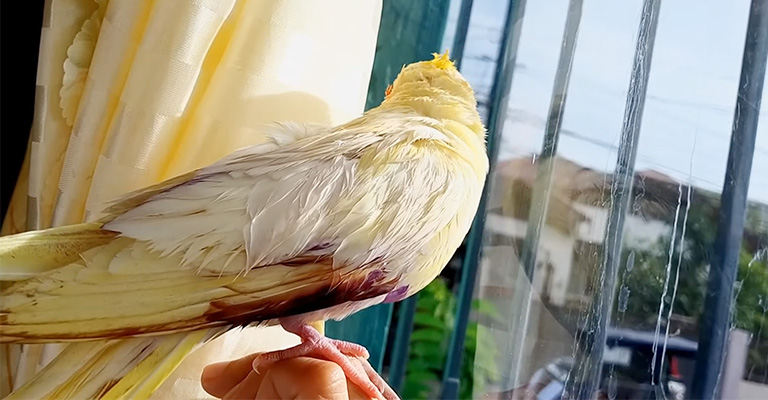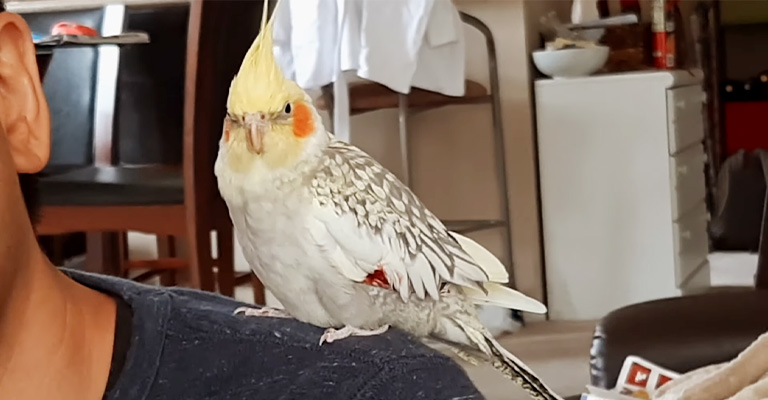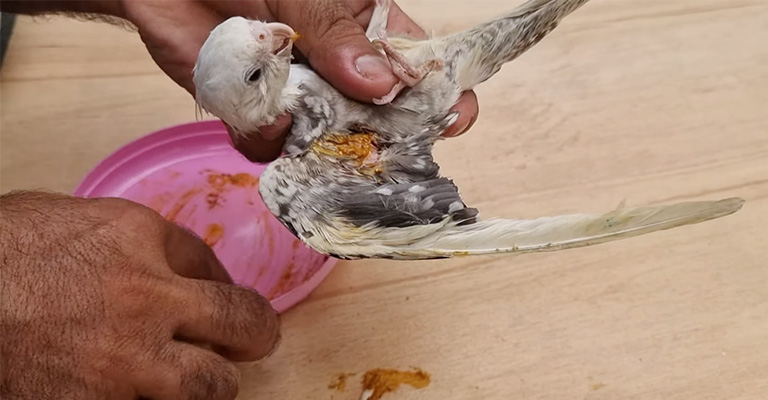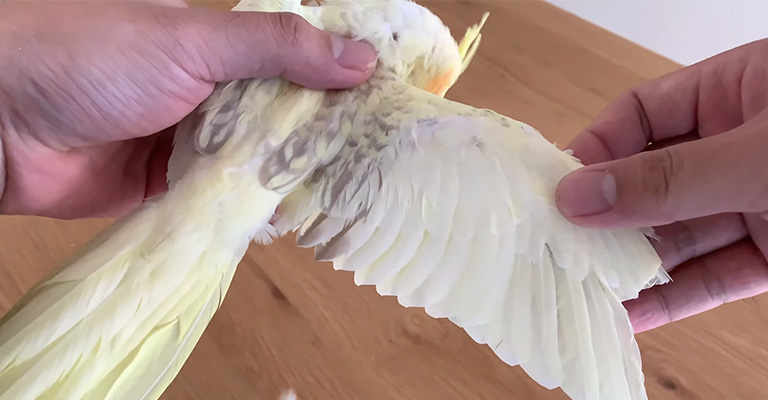Cockatiels are popular pet birds that have beautiful feathers and charming personalities. However, sometimes they may experience bleeding under their wings, which can be alarming and dangerous for their health.
In this article, we will explain the possible cause of cockatiel bleeding underwing, how to stop it, and how to prevent it from happening again.

What Is A Blood Feather?
A blood feather is a new feather growing to replace an old one. It has a blood supply from the skin that nourishes the developing feather.
The blood feather resembles a dark red spike or quill that emerges from the skin and grows into a feather shaft. The shaft is the tubular part of the feather that holds the barbs and barbules.
The blood supply recedes when the blood feather fully develops, and the shaft becomes hollow and transparent. The blood feather then becomes a standard feather that can be preened and groomed by the bird.
Why Is My Cockatiel Bleeding Under The Wing?

The most common reason a cockatiel is bleeding underwing is a broken blood feather. A blood feather can break due to various reasons, such as:
Trauma
Cockatiels are active birds and can sometimes injure themselves by flying into objects or getting their wings caught. If your bird has had any recent accidents or encounters with sharp objects, it’s possible that the bleeding is a result of physical trauma.
In such cases, it’s important to seek immediate veterinary attention to assess the severity of the injury and provide appropriate treatment.
Preening
Cockatiels may engage in excessive preening or feather picking, which can lead to self-inflicted wounds. This behavior can be triggered by various factors, such as stress, boredom, skin irritation, or hormonal imbalances.
If your cockatiel is excessively preening or plucking feathers, it could cause irritation or injury to the skin underneath the wing, leading to bleeding. Identifying the underlying cause of the behavior is crucial to addressing the issue.
Consulting with an avian veterinarian would be beneficial in such cases to determine the cause and develop a treatment plan.
Mites
The bird may have feather mites that irritate the skin and cause itching and scratching. The bird may damage its blood feathers while trying to eliminate the mites.
A broken blood feather can bleed profusely because the blood vessel inside the shaft is exposed and cannot clot easily. The bleeding can be life-threatening for a small bird like a cockatiel, as it can quickly lose a lot of blood.
How To Stop Cockatiel Bleeding Under Wing?

Suppose you notice your cockatiel bleeding under your wing. In that case, you should act quickly to stop the bleeding and prevent further complications. Here are some steps you can follow:
Calm your bird
Wrap it gently in a towel or cloth to restrain it and reduce its stress. Talk to your bird softly and reassure it that everything will be okay.
Identify the source of bleeding
Check your bird’s wing carefully and look for the broken blood feather. It should be easy to spot as it will be dark red and wet with blood. If you cannot find it, look for other possible sources of bleeding, such as cuts or wounds on the skin.
Remove the broken blood feather
If you are confident and experienced enough, you can try to remove the damaged blood feather yourself using a pair of tweezers or hemostats. Grasp the feather firmly at the base near the skin and pull it out quickly and smoothly in one motion. Do not twist or bend the feather, as this may cause more damage and pain to your bird.
Apply pressure and powder
After removing the broken blood feather, apply pressure on the wound using a sterile gauze pad or cotton ball for several seconds to help stop the bleeding. You can also use a styptic powder, cornstarch, or flour to aid clotting. Sprinkle some powder on the wound or dip the bleeding area into it. Avoid getting any powder into your bird’s eyes or nostrils.
Monitor your bird
Once the bleeding has stopped, remove it from the towel and observe it closely for any signs of shock or infection. Make sure your bird is warm, comfortable, and hydrated. Offer some treats or favorite foods to encourage eating and drinking.
Seek veterinary care
If you are uncomfortable or able to remove the broken blood feather yourself, or if the bleeding does not stop after 5 minutes of applying pressure and powder, you should take your bird to an avian veterinarian as soon as possible. Your bird may need professional help to stop the bleeding and prevent infection or anemia.
How To Prevent Cockatiel Bleeding Under The Wing?

Bleeding under the wing in cockatiels can occur for various reasons, such as injuries, feather picking, or underlying health issues. It is essential to take preventive measures to minimize the risk of bleeding and ensure the well-being of your cockatiel. Here are some steps you can take:
Providing a Safe Environment
Creating a safe and bird-friendly environment is crucial for preventing injuries that may lead to bleeding under the wing. Consider the following:
- Cage Setup: Ensure the cage is appropriately sized with no sharp edges or protruding wires that could harm your cockatiel. Provide a variety of perches of different sizes and textures to promote foot health and prevent pressure sores.
- Avoid Hazardous Objects: Remove any objects or decorations within the cage with sharp edges, small parts, or toxic materials. Cockatiels are curious birds and may injure themselves while exploring or chewing on dangerous objects.
Regular Health Check-ups
Regular veterinary check-ups are essential for monitoring your cockatiel’s overall health and detecting any underlying conditions that may lead to bleeding. Consider the following:
- Find an Avian Veterinarian: Locate a reputable avian veterinarian experienced in treating cockatiels. Regular check-ups can help identify potential health issues early on.
- Annual Examinations: Schedule annual examinations for your cockatiel, even if they appear healthy. These examinations can detect any underlying health problems and provide preventive care.
Feather Care and Maintenance
Proper feather care is essential for preventing feather picking and related issues that could result in bleeding under the wing. Consider the following:
- Provide Proper Nutrition: A balanced and nutritious diet is vital for healthy feather growth. Ensure your cockatiel’s diet includes high-quality pelleted food, fresh vegetables, fruits, and little treats. Consult an avian veterinarian for specific dietary recommendations.
- Regular Bathing or Mist Spraying: Regular bathing or mist spraying can help maintain clean feathers and prevent dryness, which may contribute to feather picking. Cockatiels often enjoy bathing in shallow water dishes or gentle mist sprays.
- Avoid Over-Mating Stimuli: Cockatiels can exhibit excessive preening or feather-picking behaviors if overly stimulated. Avoid providing nest boxes or extreme cuddling, as these may trigger hormonal behaviors leading to feather-related issues.
Monitoring and Behavioral Observation
Closely monitoring your cockatiel’s behavior and promptly addressing any changes or signs of distress is crucial for preventing and addressing issues that could result in bleeding under the wing. Consider the following:
- Observation and Interaction: Spend quality time observing and interacting with your cockatiel. This allows you to become familiar with their normal behavior, making identifying any changes or signs of discomfort easier.
- Addressing Stress and Anxiety: Cockatiels can experience stress and anxiety, which may contribute to feather picking or self-harm. Provide a calm and enriched environment with opportunities for exercise, mental stimulation, and social interaction.
- Seek Professional Advice: Consult an avian veterinarian if you notice signs of bleeding under the wing or persistent feather picking. They can assess the underlying cause, provide appropriate treatment, and offer behavioral guidance.
By implementing these preventive measures, you can minimize the risk of bleeding under the wing in your cockatiel. Remember, each bird is unique, and paying attention to their needs and seeking professional advice to ensure their well-being is essential.
FAQ
A cockatiel can lose up to 10% of its body weight in blood before it becomes critical. For an average cockatiel that weighs about 100 grams, this means about 10 ml of blood. However, this may vary depending on the bird’s age, health, and environment.
A blood feather can take anywhere from 2 to 6 weeks to grow back, depending on the type and location of the feather. Wing feathers grow faster than tail feathers, and primary feathers grow faster than secondary feathers.
A cockatiel may show signs of pain by being quiet, fluffed up, lethargic, or depressed. It may also lose its appetite, drink more water, or have changes in its droppings. It may also vocalize more or less than usual or show aggression or fear.
A cockatiel may show signs of anemia by being pale, weak, tired, or breathless. It may also have a rapid heart rate, low body temperature, or poor circulation. It may also have a reduced immune system and be more prone to infections.
You can help your cockatiel heal faster by providing a warm and comfortable environment to rest and recover. You can also offer some foods rich in iron and protein, such as egg yolk, liver, spinach, or broccoli. You can supplement your bird’s diet with vitamins and minerals that support blood health, such as vitamins K, C, calcium, and iron.
Conclusion
Cockatiel bleeding underwing is a severe condition that requires immediate attention and care. The most likely cause of bleeding is a broken blood feather that needs to be removed and treated.
You can prevent this problem by providing a safe and healthy environment for your bird and checking its feathers regularly for any issues.
You should always consult your veterinarian for advice and assistance if you have doubts or concerns about your bird’s health.